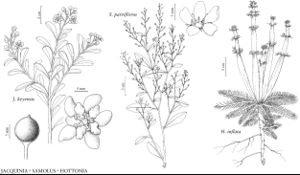Difference between revisions of "Jacquinia"
Fl. Jamaic., 27. 1759 (as Jaquinia), name and orthography conserved ,.
FNA>Volume Importer |
FNA>Volume Importer |
||
| Line 22: | Line 22: | ||
|distribution=Fla.;Mexico;West Indies;Central America;South America. | |distribution=Fla.;Mexico;West Indies;Central America;South America. | ||
|discussion=<p>Species 13 (2 in the flora).</p><!-- | |discussion=<p>Species 13 (2 in the flora).</p><!-- | ||
| − | --><p>Bonellia, with a total of 22 species, was until recently included in Jacquinia. We follow B. Ståhl and M. Källersjö (2004) in treating them separately here.</p> | + | --><p><i>Bonellia</i>, with a total of 22 species, was until recently included in <i>Jacquinia</i>. We follow B. Ståhl and M. Källersjö (2004) in treating them separately here.</p> |
|tables= | |tables= | ||
|references={{Treatment/Reference | |references={{Treatment/Reference | ||
| Line 61: | Line 61: | ||
|publication year= | |publication year= | ||
|special status= | |special status= | ||
| − | |source xml=https://jpend@bitbucket.org/aafc-mbb/fna-data-curation.git/src/ | + | |source xml=https://jpend@bitbucket.org/aafc-mbb/fna-data-curation.git/src/8f726806613d60c220dc4493de13607dd3150896/coarse_grained_fna_xml/V8/V8_520.xml |
|genus=Jacquinia | |genus=Jacquinia | ||
}}<!-- | }}<!-- | ||
-->[[Category:Treatment]][[Category:Theophrastaceae]] | -->[[Category:Treatment]][[Category:Theophrastaceae]] | ||
Revision as of 19:07, 18 September 2019
Shrubs or trees, resin canals absent. Stems erect, much-branched; young branches lepidote, hairs irregularly branched, thick-walled. Leaves alternate, sometimes pseudoverticillate; blade oblong-obovate to spatulate, base attenuate, margins entire, apex obtuse to rounded or retuse, mucronate or mucro absent, surfaces glabrous, punctate. Inflorescences terminal [axillary] racemes, 4–30(–40)-flowered, pedunculate. Pedicels present, bracteate. Flowers: sepals distinct; corolla white or cream, darkening to yellow with age, salverform or short-campanulate, lobes shorter to longer than tube, apex rounded to acute; stamens borne at base of corolla tube; filaments distinct; anthers at first aggregated around stigma and style, later spreading; staminodes borne at apex of corolla tube, petaloid; stigma capitate, lobed. Berries orange-red or red, ovoid or globose, apex apiculate. Seeds 2–8, brown or light brown, oblong to elliptic, subglobose, alveolate, completely covered by placental tissue. x = 18.
Distribution
Fla., Mexico, West Indies, Central America, South America.
Discussion
Species 13 (2 in the flora).
Bonellia, with a total of 22 species, was until recently included in Jacquinia. We follow B. Ståhl and M. Källersjö (2004) in treating them separately here.
Selected References
Lower Taxa
Key
| 1 | Leaves alternate or indistinctly pseudoverticillate, blade 1-4.5 × 0.5-2.5 cm, petiole puberulous-lepidote. | Jacquinia keyensis |
| 1 | Leaves usually distinctly pseudoverticillate, blade 3-8(-12) × 1.5-5 cm, petiole glabrous or sparsely puberulous. | Jacquinia arborea |
